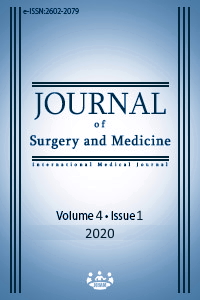Do inflammatory markers play a role in the detection of periprosthetic infections?
Keywords:
White blood cell, Biomarker, C-reactive protein, Prosthetic infectionAbstract
Aim: Periprosthetic joint infection after total hip or knee arthroplasty is one of the most feared complications. The aim of this study was to evaluate the efficacy of inflammatory biomarkers in identifying periprosthetic joint infection.
Methods: This cross-sectional and bi-centered study included 131 patients, who had suspected prosthesis infection and underwent three-phase bone scintigraphy. Patients were divided into three groups according to the Musculoskeletal Infection Society criteria and scintigraphic study results: Group 1 comprised cases with prosthetic infection, Group 2 included aseptic loosening cases and Group 3 included cases with healthy prostheses.
Results: White blood cell average was 11.5 (3.2) 109/L in group 1, 8. (2.1) 109/L in group 2 and 7.9 (2.1) 109/L in group 3, among which it was significantly higher in Group 1 compared to Groups 2 and 3, (P<0.001, P<0.001), while there was no significant difference between groups 2 and 3 (P=0.753). C reactive protein values (CRP) were 46.6 (50.0) mg/L in group 1, 18.8 (17.5) mg/L in group 2 and 15.3 (17.1) mg/L in group 3, significantly higher in group 1 than the other groups (P<0.001, P<0.001), and similar in Groups 2 and 3 (P=0.876). The mean erythrocyte sedimentation rate values did not differ significantly between the groups.
Conclusion: The use of three-phase bone scintigraphy and inflammatory biomarkers such as C reactive protein and white blood cell have been shown to be effective in predicting prosthetic infection.
Downloads
References
Love C, Marwin SE, Palestro CJ. Nuclear medicine and the infected joint replacement. Semin Nucl Med. 2009 Jan;39(1):66-78.
Oleske DM, Bonafede MM, Jick S, Ji M, Hall JA. Electronic health databases for epidemiologica research on joint replacements: considerations when making cross-national comparisons. Ann Epidemiol. 2014 Sep;24(9):660-5.
Kurtz S, Ong K, Lau E, Mowat F, Halpern M. Projections of primary and revision hip and knee arthroplasty in the United States from 2005 to 2030. J Bone Joint Surg Am. 2007 Apr;89(4):780-5.
Parvizi J, Shohat N, Gehrke T. Prevention of periprosthetic joint infection: new guidelines. Bone Joint J. 2017 Apr;99-B(4 Supple B):3-10.
Li C, Renz N, Trampuz A. Management of Periprosthetic Joint Infection. Hip Pelvis. 2018 Sep;30(3):138-46.
Trampuz A, Steckelberg JM, Osmon DR, Cockerill FR, Hanssen A and Patel R. Advances in the laboratory diagnosis of prosthetic joint infection. Reviews in Medical Microbiology 2003;14(1):1–14.
Parvizi J, Zmistowski B, Berbari EF, Bauer TW, Springer BD, Della Valle CJ, et al. New definition for periprosthetic joint infection: from the Workgroup of the Musculoskeletal Infection Society. Clin Orthop Relat Res. 2011;469:2992–4.
Corvec S, Portillo ME, Pasticci BM, Borens O, Trampuz A. Epidemiology and new developments in the diagnosis of prosthetic joint infection. Int J Artif Organs. 2012 Oct;35(10):923-34.
Kurtz SM, Ong KL, Schmier J, Mowat F, Saleh K, Dybvik E, et al. Future clinical and economic impact of revision total hip and knee arthroplasty. J Bone Joint Surg Am. 2007 Oct;89 Suppl 3:144-51.
Cataldo MA, Petrosillo N, Cipriani M, Cauda R, Tacconelli E. Prosthetic joint infection: recent developments in diagnosis and management. J Infect. 2010 Dec;61(6):443-8.
Kapadia BH, McElroy MJ, Issa K, Johnson AJ, Bozic KJ, Mont MA. The economic impact of periprosthetic infections following total knee arthroplasty at a specialized tertiary-care center. J Arthroplasty. 2014 May;29(5):929-32.
Alp E, Cevahir F, Ersoy S, Guney A. Incidence and economic burden of prosthetic joint infections in a university hospital: A report from a middle-incomecountry. J Infect Public Health. 2016 Jul-Aug;9(4):494-8.
Deirmengian C, Kardos K, Kilmartin P, Cameron A, Schiller K, Parvizi J. Diagnosing periprosthetic joint infection: has theera of the biomarker arrived? Clin Orthop Relat Res. 2014 Nov;472(11):3254-62.
Xiong L, Li S, Dai M. Comparison of D-dimer with CRP and ESR for diagnosis of periprosthetic joint infection. J Orthop Surg Res. 2019 Jul 29;14(1):240.
Qin L, Li F, Gong X, Wang J, Huang W, Hu N. Combined Measurement of D-Dimer and C-Reactive Protein Levels: Highly Accurate for Diagnosing Chronic Periprosthetic Joint Infection. J Arthroplasty. 2019 Aug 9. pii: S0883-5403(19)30743-0. doi: 10.1016/j.arth.2019.08.012.
Kim TW, Kim DH, Oh WS, Sim JA, Lee YS, Lee BK. Analysis of theCauses of Elevated C-Reactive Protein Level in the Early Postoperative Period After Primary Total Knee Arthroplasty. J Arthroplasty. 2016 Sep;31(9):1990-6.
Lenski M, Scherer MA. Diagnostic potential of inflammatory markers in septic arthritis and periprosthetic joint infections: a clinical study with 719 patients. Infect Dis (Lond). 2015 Jun;47(6):399-409.
Alijanipour P, Bakhshi H, Parvizi J. Diagnosis of periprosthetic joint infection: the threshold for serological markers. Clin Orthop Relat Res. 2013 Oct;471(10):3186-95.
Schinsky MF, DellaValle CJ, Sporer SM, Paprosky WG. Perioperative testing for joint infection in patients undergoing revision total hip arthroplasty. J Bone Joint Surg Am. 2008 Sep;90(9):1869-75.
Friedrich MJ, Randau TM, Wimmer MD, Reichert B, Kuberra D, Stoffel-Wagner B, et al. Lipopolysaccharide-binding protein: a valuable biomarker in the differentiation between periprosthetic joint infection and aseptic loosening? Int Orthop. 2014 Oct;38(10):2201-7.
Bottner F, Wegner A, Winkelmann W, Becker K, Erren M, Götze C. Interleukin-6, procalcitonin and TNF-alpha: markers of peri-prosthetic infection following total joint replacement. J Bone Joint Surg Br. 2007 Jan;89(1):94-9.
Downloads
- 675 1124
Published
Issue
Section
How to Cite
License
Copyright (c) 2020 Duran Topak, Ahmet Salan, Fatih Doğar, Selçuk Nazik
This work is licensed under a Creative Commons Attribution-NonCommercial-NoDerivatives 4.0 International License.
















